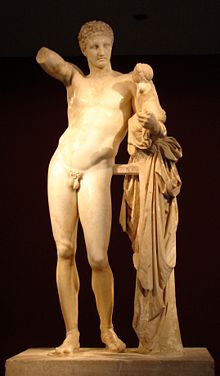
Original
The Hermes of Olympia is a marble group of the Greek god Hermes with the Dionysus boy on his arm.
It is dated around 340 BC and in Greek art it marks the transition from late classical to early Hellenistic. The sculpture is attributed to the sculptor Praxiteles. It is located in the Olympic Museum. The lower legs of the statue are completed today. The statue was found on 8 May 1877 during excavations in the Cella des Heratempels in Olympia under the direction of Gustav Hirschfeld. This discovery was a sensation in archaeology. Since Pausanias mentions this statue in the Heraion of Olympia in the 2nd century A. D., it can be assumed that the statue group was found at its original site.
The right leg and the tree trunk are bearers of the composition. The tree trunk with the garment thrown over it contrasts with the smooth body of God. The raised left arm, which carries the little Dionysus, corresponded to the raised right arm, whose hand probably held a bunch of grapes towards the boy. The ponderation of the body, i. e. the hip swing and the relationship of the supporting leg to the playing leg as a counterpost, reveals the influence of the classical sculpture school according to Polyclet, the leg proportions of Hermes the stylistic influence of Lysipp, who was a pupil of Polyclet.
Exhibit in the museum in Olympia under the inventory no. 17, replica reduction (original 2.13 m high, also this large statue is available).